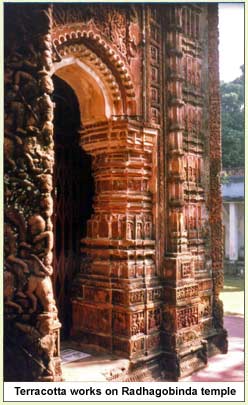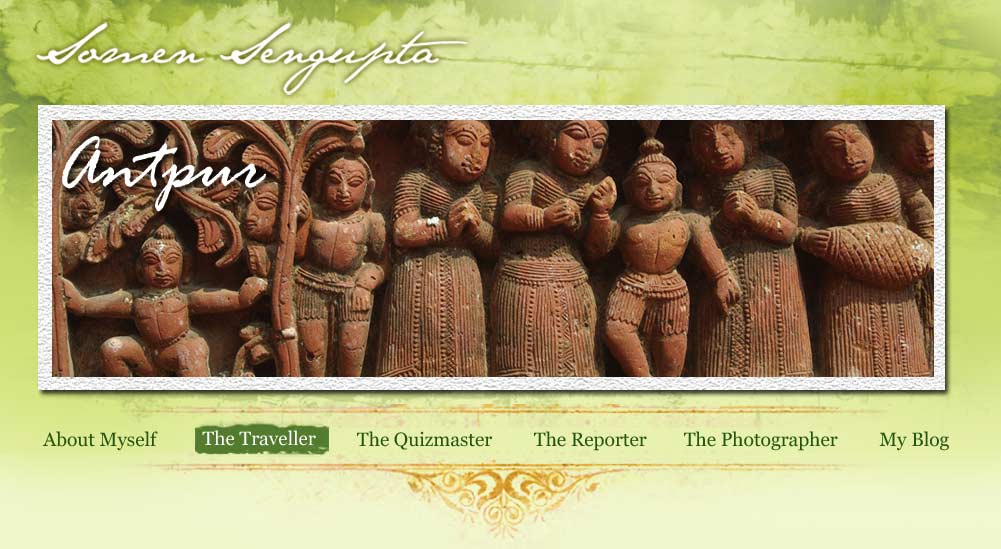| Hardly 50 km from Calcutta, Antpur is home to one of the finest pieces of terracotta architecture in the world. A mute testament to the glorious past of Bengal, the Radhagobinda temple, is a 20-minute rickshaw ride from Jangipara.The rich history of the village dates back to early 17th century. The place was then called Vishhari. Legend has it that a king named Bhuri Shreshtha used to rule the region. Eight of his trusted senapatis lived in eight adjacent villages. Later, the villages combined to form a hamlet, which derived its name from Aatpur or Antput.
In 1786, Krishnaram Mitra, dewan of the royal state of Burdwan, first took the initiative to build a Krishna temple here. It was tumultuous time in the history of Bengal. The power of the Muslim rulers was at an ebb, and overseas invaders like the British, Dutch, French and Portuguese were becoming dominant. The aim behind building the temple was to motivate the Hindus, who bore the brunt of the tyranny of the outsiders. By then, terracotta craft was no longer a preserve of the artisans of Bankura and Vishnupur. The magic of clay was being used in architecture in all corners of Bengal. Antpur, with its rich cultural heritage, was no exception. Terracotta became the automatic choice for the temple.
Clay from the Ganga was brought and burnt to build the 100-ft high and 47-ft wide structure, adorned with peerless depictions of episodes from Hindu mythology and Bengali social life. The Radhagobinda temple in the village bears characteristics of the Bengal school of architecture. The aatchala or Bangla style, typical of the school, is completely different from the design of north or south Indian temples. The temple is rectangular and covered by two sloping roofs, one over the other. The real beauty of the temple is on its facade, replete with carvings from Hindu mythology, the Ramayana and the Mahabharata.
Episodes from the life of Krishna are also depicted. In fact, figures of Radha and Krishna are the most conspicuous. Mahishasurmardini Durga with her family can also be seen. At the time of the construction of the temple, Durga puja was reintroduced among Bengalis by Raja Nabakrishna Dev. The impact of the move can be gauged from the fact that Durga is depicted even on a Vaishnav temple like this.
Social lives of the royals and commoners are also sculpted on the walls of the temple. A few panels even illustrate the lives of the Europeans. Hindu symbols like lotus and shankha are abundant, as are scenes of fighting and sporting activity, of elephants and tigers. A massive snake statue reaches up to the first floor from the the front side of the temple. The terracotta figures are mostly bright red. A few have turned black with age.
Besides the temple is a wooden chandimandap that Shri Ramakrishna Paramhansa had visited.A stone's throw away is the residence of Swami Premananda (Baburam Ghosh), a direct disciple of Ramakrishna. On December 24, 1886, nine of Ramakrishna?s direct disciples had assembled here to take an oath to dedicate their lives to the service of mankind. One of them was Narendranath Dutta, who later became Swami Vivekananda. Swami Avedananda was also present.
Vivekananda visited this house again in 1889. A simple shrine commemorates the visits.
Antpur is significant in the history of Indian Railways as well. The village was an important station on the 45-km Howrah-Amta narrow-gauge route of the Martin Light Railway Company, a private rail service established in 1892. The rail company was shut down in the 1950s, and the tourist flow to the village declined gradually after that.
Poet Vishnu Dey and minister Ashoke Sen, however, came back several times, lured by Antpur's solitude and beauty. |



